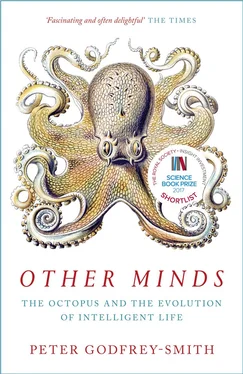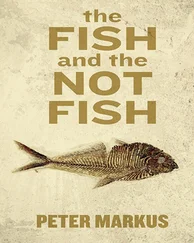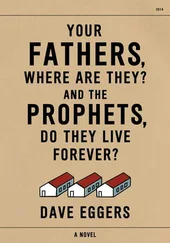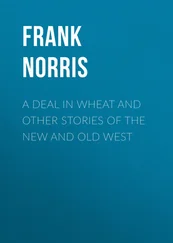CONTENTS Cover Title Page Copyright Dedication Epigraph 1. Meetings Across the Tree of Life 2. A History of Animals 3. Mischief and Craft 4. From White Noise to Consciousness 5. Making Colors 6. Our Minds and Others 7. Experience Compressed 8. Octopolis Notes Index Acknowledgments Also by Peter Godfrey-Smith About the Publisher
COPYRIGHT CONTENTS Cover Title Page Copyright Dedication Epigraph 1. Meetings Across the Tree of Life 2. A History of Animals 3. Mischief and Craft 4. From White Noise to Consciousness 5. Making Colors 6. Our Minds and Others 7. Experience Compressed 8. Octopolis Notes Index Acknowledgments Also by Peter Godfrey-Smith About the Publisher
William Collins
An imprint of HarperCollins Publishers
1 London Bridge Street
London SE1 9GF
WilliamCollinsBooks.com
This eBook first published in Great Britain by William Collins in 2017
First published in the United States of America by Farrar, Straus and Giroux in 2016 as Other Minds: The Octopus, the Sea, and the Deep Origins of Consciousness
Copyright © Peter Godfrey-Smith 2016
An excerpt from Other Minds originally appeared, in slightly different form, in Scientific American .
Cover art: Kunstformen der Natur (1904), plate 54: Gamochonia, Octopus vulgaris by Ernst Haeckel
All photographs were taken by the author, unless otherwise stated
Drawn figures are by the author, unless otherwise stated
Peter Godfrey-Smith asserts the moral right to be identified as the author of this work
A catalogue record for this book is available from the British Library
All rights reserved under International and Pan-American Copyright Conventions. By payment of the required fees, you have been granted the non-exclusive, non-transferable right to access and read the text of this e-book on-screen. No part of this text may be reproduced, transmitted, down-loaded, decompiled, reverse engineered, or stored in or introduced into any information storage and retrieval system, in any form or by any means, whether electronic or mechanical, now known or hereinafter invented, without the express written permission of HarperCollins.
Source ISBN: 9780008226299
Ebook Edition © March 2017 ISBN: 9780008226282
Version: 2018-01-11
DEDICATION CONTENTS Cover Title Page Copyright Dedication Epigraph 1. Meetings Across the Tree of Life 2. A History of Animals 3. Mischief and Craft 4. From White Noise to Consciousness 5. Making Colors 6. Our Minds and Others 7. Experience Compressed 8. Octopolis Notes Index Acknowledgments Also by Peter Godfrey-Smith About the Publisher
For all those who work to protect the oceans
EPIGRAPH CONTENTS Cover Title Page Copyright Dedication Epigraph 1. Meetings Across the Tree of Life 2. A History of Animals 3. Mischief and Craft 4. From White Noise to Consciousness 5. Making Colors 6. Our Minds and Others 7. Experience Compressed 8. Octopolis Notes Index Acknowledgments Also by Peter Godfrey-Smith About the Publisher
The demand for continuity has, over large tracts of science, proved itself to possess true prophetic power. We ought therefore ourselves sincerely to try every possible mode of conceiving the dawn of consciousness so that it may not appear equivalent to the irruption into the universe of a new nature, non-existent until then.
– William James, The Principles of Psychology , 1890
The drama of creation, according to the Hawaiian account, is divided into a series of stages … At first the lowly zoophytes and corals come into being, and these are followed by worms and shellfish, each type being declared to conquer and destroy its predecessor, a struggle for existence in which the strongest survive. Parallel with this evolution of animal forms, plant life begins on land and in the sea – at first with the algae, followed by seaweeds and rushes. As type follows type, the accumulating slime of their decay raises the land above the waters, in which, as spectator of all, swims the octopus, the lone survivor from an earlier world.
– Roland Dixon, Oceanic Mythology , 1916
Cover
Title Page CONTENTS Cover Title Page Copyright Dedication Epigraph 1. Meetings Across the Tree of Life 2. A History of Animals 3. Mischief and Craft 4. From White Noise to Consciousness 5. Making Colors 6. Our Minds and Others 7. Experience Compressed 8. Octopolis Notes Index Acknowledgments Also by Peter Godfrey-Smith About the Publisher
Copyright
Dedication
Epigraph
1. Meetings Across the Tree of Life
2. A History of Animals
3. Mischief and Craft
4. From White Noise to Consciousness
5. Making Colors
6. Our Minds and Others
7. Experience Compressed
8. Octopolis
Notes
Index
Acknowledgments
Also by Peter Godfrey-Smith
About the Publisher
1
MEETINGS ACROSS THE TREE OF LIFE
Two Meetings and a Departure
On a spring morning in 2009, Matthew Lawrence dropped the anchor of his small boat at a random spot in the middle of a blue ocean bay on the east coast of Australia, and jumped over the side. He swam down on scuba to where the anchor lay, picked it up, and waited. The breeze on the surface nudged the boat, which started to drift, and Matt, holding the anchor, followed.
This bay is well-known for diving, but divers usually visit only a couple of spectacular locations. As the bay is large and typically pretty calm, Matt, a scuba enthusiast who lives nearby, had begun a program of underwater exploration, letting the breeze carry the empty boat around above him until his air ran out and he swam back up the anchor line. On one of these dives, roaming over a flat sandy area scattered with scallops, he came across something unusual. A pile of empty scallop shells – thousands of them – was roughly centered around what looked like a single rock. On the shell bed were about a dozen octopuses, each in a shallow, excavated den. Matt came down and hovered beside them. The octopuses each had a body about the size of a football, or smaller. They sat with their arms tucked away. They were mostly brown-gray, but their colors changed moment by moment. Their eyes were large, and not too dissimilar to human eyes, except for the dark horizontal pupils – like cats’ eyes turned on their side.
The octopuses watched Matt, and also watched one another. Some started roaming around. They’d haul themselves out of their dens and move over the shell bed in an ambling shuffle. Sometimes this elicited no response from others, but occasionally a pair would dissolve into a multi-armed wrestle. The octopuses seemed to be neither friends nor enemies, but in a state of complicated coexistence. As if the scene were not sufficiently strange, many baby sharks, each just six inches or so long, lay quietly on the shells as the octopuses roamed around them.
A couple of years before this I was snorkeling in another bay, in Sydney. This site is full of boulders and reefs. I saw something moving under a ledge – something surprisingly large – and went down to look at it. What I found looked like an octopus attached to a turtle. It had a flat body, a prominent head, and eight arms coming straight from the head. The arms were flexible, with suckers – roughly like octopus arms. Its back was fringed with something that looked like a skirt, a few inches wide and moving gently. The animal seemed to be every color at once – red, gray, blue-green. Patterns came and went in a fraction of a second. Amid the patches of color were veins of silver like glowing power lines. The animal hovered a few inches above the sea floor, and then came forward to look at me. As I had suspected from the surface, this creature was big – about three feet long. The arms roved and wandered, the colors came and went, and the animal moved forward and back.
Читать дальше












